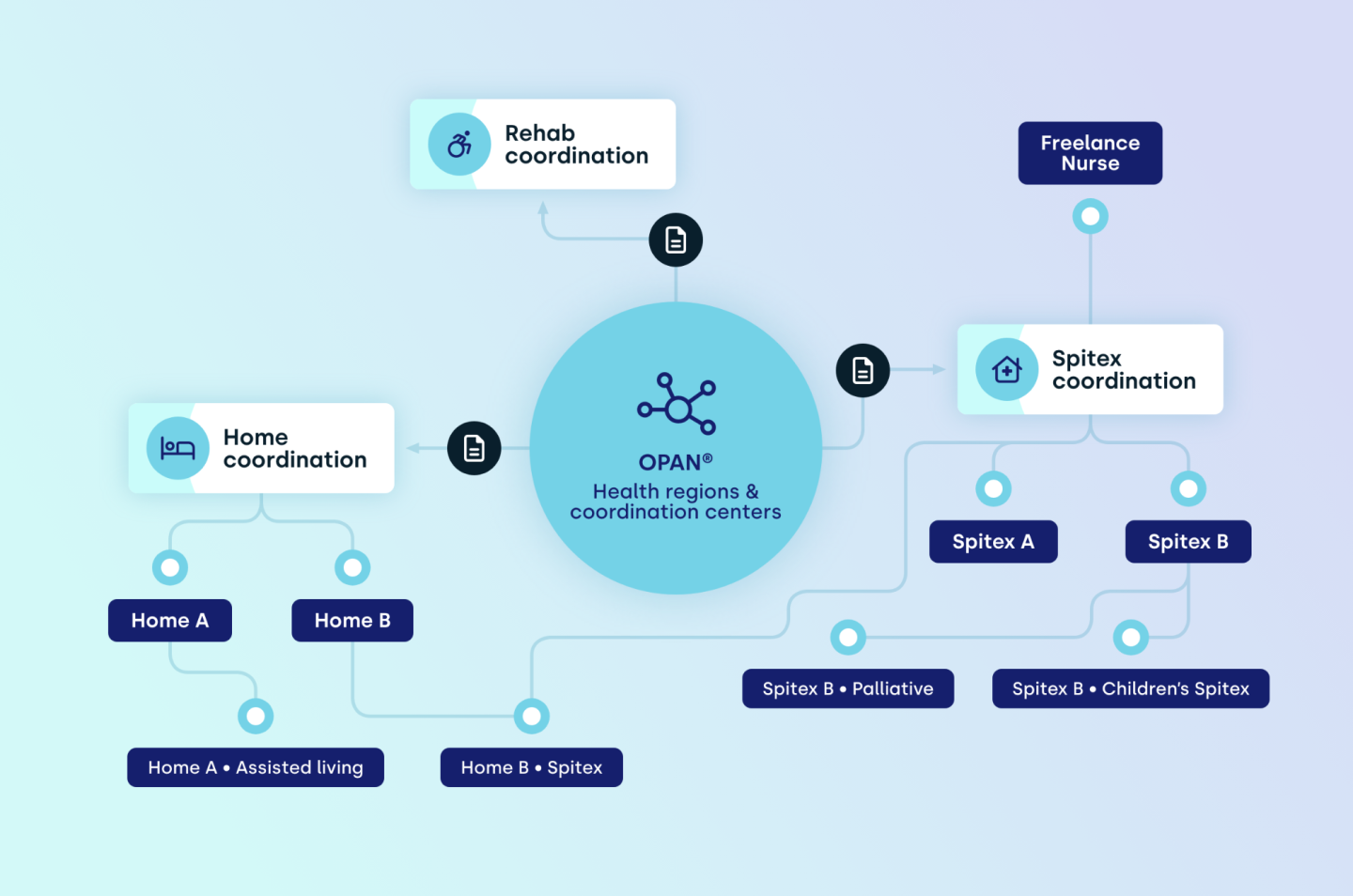Health Regions & Coordination Centers
Health Regions & Coordination Centers
Efficiently coordinate networked care - with OPAN® as the central hub
In today's healthcare landscape, where the importance of integrated care concepts is increasing, health regions, networks, and coordination centers play a central role. OPAN® represents an innovative platform specifically designed to meet these new challenges. With its flexible structure, OPAN® offers a system that facilitates coordination and mediation between various service providers.

Efficient coordination processes
Within OPAN®, health regions can act as first points of contact, seamlessly referring patients to the appropriate specialist services. This is especially true for complex cases that require coordinated support from different services. OPAN® simplifies this process by providing a platform on which services can be effectively coordinated and information securely exchanged.
Flexible organizational structures
OPAN® offers flexible organizational structures that can be individually configured. Different service providers can be integrated at different levels within a hierarchy tree. In addition, OPAN® enables differentiated assignment of user authorizations at various levels.
For example, a health region could include both a coordination office for homes with several affiliated homes and a coordination office for Spitex services, whereby the respective service providers can in turn have their own sub-organizations.
Advantages for health regions and coordination centers
Examples of coordination
Spitex coordination
Spitex registrations are received centrally for a definable area. The coordination office can triage these registrations within the health region. Triage can be made to all organizations within the health region. This can include public Spitex organizations, private Spitex organizations, children's Spitex, palliative Spitex specialized care or freelance care professionals. Organizations in the areas of home economics, counselling and care or Pro Senectute can also be linked to the health region within OPAN® so that triage can be as versatile as possible.
Home coordination
Inquiries and registrations for care homes, children's homes and homes for the disabled can be received and coordinated centrally. The coordination office then takes care of the individual allocation to the appropriate home. It is also possible to find and coordinate alternative solutions such as assisted living in combination with Spitex services.
Benefit from the following features
OPAN® offers standardized workflows for applications and transitions to aftercare institutions. The system enables flexible transmission processes, where initial applications can be gradually supplemented with additional data, either manually or automatically through interfaces.
Providers benefit from a central entry point for applications, enabling efficient coordination of admissions. Information can be transmitted to specialized applications via interfaces. This structured approach promotes targeted communication and prevents the loss of important information in the flood of emails.
The workflow thus supports efficient and transparent handling of the entire application process.
The OPAN® case communication module enables the structured exchange of information on patient cases within and between healthcare facilities.
It distinguishes between internal and external comments, with internal comments visible only to the user's own organization. The module provides a chronological comment history, facilitating the tracking of decision-making processes. For data protection reasons, comment contents are not sent by email; instead, users receive notifications about new comments. Notification settings are customizable. Comments can be marked as read and are visible in PDF documents. The module supports integration into existing systems through interfaces.
Sub-orders (planned)
The importance of interprofessional collaboration is continuously growing. Within OPAN®, organizations can pass on sub-orders from received applications and inquiries internally or to partner organizations. These sub-orders include a selection of relevant information from the original application, supplemented by specific instructions for the executing organization.
In the home care sector, for example, this could mean that an application for household support is forwarded to a specialized partner organization, or that an application for assisted living results in additional home care nursing services. Further details can be clarified and exchanged traceably on the sub-order using case communication.
Flexible Forwarding in OPAN®
OPAN® offers functions for internal and external forwarding of applications, messages, and requests. Internally, entries can be forwarded between departments, for example, from central dispatch to triage. Externally, the system allows forwarding to partner organizations.
Providers can link as many partners as needed, such as home care organizations, freelance nurses, nursing homes, or other healthcare facilities. If necessary, for instance, when a task cannot be performed by oneself, an application can be forwarded to a partner. The partner is automatically notified and assumes responsibility for the application. This functionality promotes efficient work processes and resource utilization.
The OPAN® capacity management module enables efficient management and communication of available spaces in outpatient and inpatient aftercare institutions. Referrers receive real-time access to current capacity information, including detailed information on various offers and room categories.
Providers can easily update capacity data via a user interface, choosing between exact numbers and general availability. The system offers customizable reminders for regular updates.
It reduces administrative effort by minimizing phone inquiries and redundant transmissions to hospitals. This optimizes the referral process and occupancy efficiency for all involved.
Statistics & Reporting
With OPAN®, organizations and groups can retrieve comprehensive statistics. These include, for example, which organization has sent how many applications to which provider. Providers can thus identify their main referrers and see who sends the most applications or messages.
These statistics support the analysis of admission and discharge processes and enable targeted optimization. They provide valuable insights that contribute to improving collaboration and efficiency among the various stakeholders in the healthcare sector.
Data Protection and Privacy
The OPAN® platform places the highest value on data protection and safeguarding its users' privacy. Through a sophisticated authorization system, access rights can be precisely controlled.
For example, a coordination team can gain insight into order details without having access to sensitive patient data. Special configuration options allow specific information to be selectively hidden. This ensures that only authorized users can access sensitive data.
